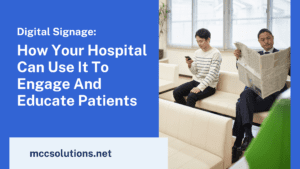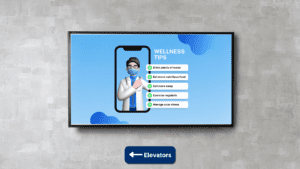
In healthcare technology, digital signage is emerging as a potent solution to address patient communication in medical facilities. Delivering precise and timely health-related information to patients is critical to foster robust relationships with them. According to a 2021 article by Patient Safety Network, open dialogue between medical professionals and patients and their families can widen perspectives, offer fresh insights, and mitigate long-term emotional effects and avoidance of doctors or facilities involved in errors or general medical care. By leveraging the power of medical technology like digital signage, we can significantly enhance patient education and engagement, bridging the existing communication gap.
Healthcare communications is a rapidly changing industry. As technology evolves, so do how healthcare providers can communicate with their patients and keep up with medical developments. Digital signage provides an opportunity to reach people worldwide, regardless of where they are or what time of day.
The right digital signage program in healthcare facilities can help improve the patient experience.
The right digital signage program in healthcare facilities can help improve the patient experience. You want your facility to be an inviting destination for patients who are likely already going through a difficult time in their lives. According to research by Graham Davey, a professor emeritus of psychology at Sussex University in the UK and editor-in-chief of the Journal of Experimental Psychopathology, negative news bulletins can lead to increased anxiety and an increased tendency to “catastrophize a personal worry.” For patients who are already in an increased state of worry over their health concerns, sitting in the lobby watching the news might not be the best use of their time. Instead, customized digital signage with patient education and engaging content could help to alleviate some of their worries.
Digital signage has proven to be useful for improving patient education and engagement. It can also be used as a communication tool between doctors, nurses, and other staff members, allowing them to communicate important information quickly and effectively. Digital signage is a cost-effective way to provide clear and easy-to-understand instructions and procedure updates—all while maintaining your hospital’s reputation for providing excellent patient care!

Digital signage provides a new way to educate and engage patients.
- Digital signage can help healthcare providers better connect with their patients. This can be done by showing them an updated schedule of appointments, highlighting new services available at the facility, or even just providing a quick way to answer basic questions about what they’re seeing or experiencing (e.g., “How do I know if I have diabetes?”). Digital signage can also help patients feel more comfortable in unfamiliar environments by offering information on where to find restrooms and how to get around the hospital more efficiently.
- Digital signage can educate patients on the health system’s services, treatments, and procedures. It also helps patients better understand their conditions and treatment options.
- Digital signage can keep patients up-to-date on healthcare events like workshops or conferences relevant to them or the community. This will keep them from missing out on important information they might need if they cannot attend in person.
- Healthcare providers themselves can use digital signage as a new way of communicating with one another about patient care issues without having to actively seek out each other’s presence in person or via phone calls/texts/emails (which could take time away from direct care).
Healthcare facilities can take advantage of patient waiting time by providing engaging patient education, building stronger relationships with patients and improving the overall patient experience.
Digital signs are a powerful and impactful way to communicate with patients, building stronger relationships between the facility and its visitors. In today’s world, digital signage allows you to reach a broad audience in multiple locations throughout your medical center or hospital.
The healthcare industry is quickly adapting to this new technology – using digital signage as an educational tool for patients who may not have been able to access it before. Healthcare facilities can take advantage of patient waiting time by providing engaging patient education, building stronger relationships with patients, and improving the overall patient experience. Digital signage is quickly becoming essential for any healthcare facility that wants to remain competitive and keep its patients returning. It is a powerful tool that can be used to educate patients and provide information about the services your office offers.
Patients will be more involved in their own care.
As healthcare becomes more patient-centric, patients will be more involved in their own care. Patients can become more proactive about their healthcare and treatment, which means they’ll be able to take an active role in how they recover. They’ll be able to ask questions about their condition and treatment plan—and get answers from a specialist who understands the latest research.
Providing patients access to information about common conditions through digital signage will help them better understand what’s going on with their bodies and make informed decisions about staying healthy. This is especially important for patients who don’t have a primary care provider. Without a PCP, it can be difficult for people to get the care they need. But with digital signage in your waiting room, you can help patients make better decisions about their health. You’ll also be able to educate them on common conditions affecting people of all ages—so they’ll know when they should seek medical attention and how to prevent further health problems.
Healthcare facilities can use digital signage to improve the overall patient experience.
Digital signage is a great way to engage patients while waiting and provide vital information to improve patient experience.
For example, if it’s flu season, digital signage can provide reminders about preventing getting sick and tips on what to do if you do get sick. Digital signage can also educate patients waiting in the waiting room or other common areas like cafeterias or reception areas on medical procedures and insurance processes.
Understand your message delivery needs in the context of healthcare technology and determine the role of digital signage in your overall engagement strategy.
When considering implementing digital signage in your healthcare communications, the first step is understanding the type of messages you’re trying to deliver and where digital signage fits your overall engagement strategy. Why are you using digital signage? What does it mean for your organization? And how does that translate into practical terms for delivering meaningful messages? The answers to these questions will help determine the type of technology and content you need and how best to use it.
With so many options available, knowing where to start and how best to use digital signage can be difficult. That’s why we’ve put together this guide to help you think through the questions above and plan a course of action that will serve your organization today and in the future.
Choose messages that are important for all patients to see.
Choose messages that are important for all patients to see. Be sure that your messages are relevant to all patients. For example, the entire patient population should be informed of urgent messages, such as a flu shot clinic or a new treatment option. Too specific messages will only engage a small portion of your patients, so focus on more general educational information, patient success stories, way-finding, etc., in the lobby areas. For larger hospital facilities, personalize the information on your signage to the type of patients seeing the signage. For example, on the pediatrics floor, provide information about avoiding childhood illnesses and easy tips to get children to eat healthy foods.
Crank up the volume on those visuals!
Make sure your visuals are big and bold. Visuals are more powerful than text, so use them to create the vibe you want to convey. Use bold, simple visuals that are easy to read from a distance. And keep it simple! Don’t overload your screens with too much text or information; that’s how people get confused and tune out. Keep it short and sweet by using minimal copy on your signs and posters—keep it focused on one idea per screen—and make sure they’re large enough for people in the back row to see clearly.
These displays can be installed throughout your healthcare facility—from the lobby to waiting rooms, hallways, and anywhere else where patients gather.
Digital signage is a great way to get your message out to the public, but it doesn’t have to be placed in just the waiting room. Digital signage displays can go throughout your healthcare facility, from the lobby to waiting rooms, hallways, and other places where patients congregate.
Digital signage can be used for many things: displaying information about new services or procedures; encouraging patients with healthy living tips; promoting upcoming events such as blood drives or screenings; providing educational materials like videos or handouts on a variety of topics relevant to your practice (e.g., flu shots).
Keep it short and sweet.
The key to effective healthcare communications is keeping it short and sweet. With a busy schedule, many people’s attention spans have shrunk, and it’s hard to keep them focused on one thing for very long. You need your message to be clear so that your audience can understand it quickly, but you also want it to stand out from other content that may be competing for their attention.
Graphics are great for helping make your message more exciting and provide an opportunity for branding elements such as logos or colors (essential if you have multiple locations).
Digital signage could allow you to create a better experience for your patients while they are with you!
Digital signage can be added to your existing healthcare technology in many ways. Digital signage can help you communicate with patients and build stronger relationships with them. It can also improve the overall patient experience by engaging the waiting room, increasing patient retention rates, and providing information to help them feel more comfortable during their visit.
So, what have we learned? First, digital signage is an exciting and valuable tool for healthcare facilities. Second, it can help take some of the pressure off of your staff by providing educational content to patients in a way that’s easy to digest and understand. Finally, there are many ways you can use this technology within your facility to improve patient engagement and satisfaction levels!
Schedule a demo with one of our Digital Signage experts to learn more about this exciting technology and how it can improve patient communications.




